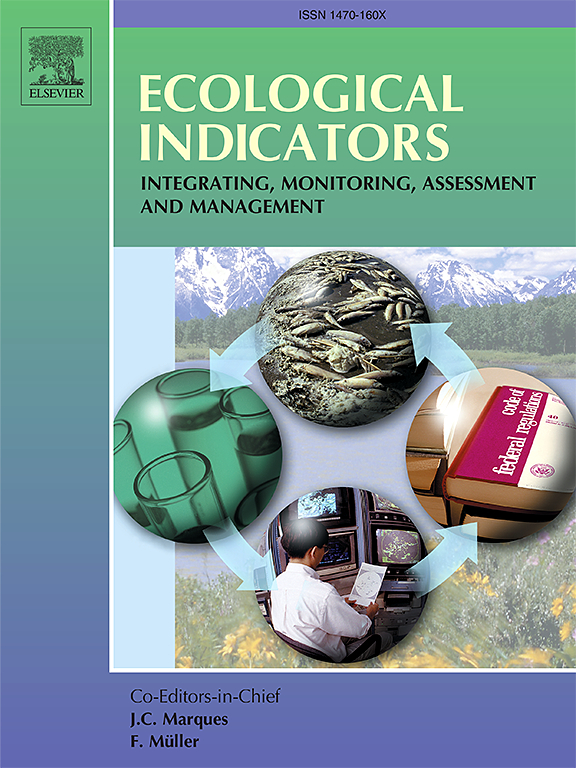环境 DNA 代谢编码揭示浮游植物和浮游动物对河道沿岸梯级水坝的不同反应
IF 7
2区 环境科学与生态学
Q1 ENVIRONMENTAL SCIENCES
引用次数: 0
摘要
尽管梯级大坝为人类社会提供了重要帮助,但也会对河流生态系统产生负面影响。作为河流生态系统的重要组成部分,浮游植物和浮游动物对梯级水坝的反应很少被同时研究,因此缺乏对它们之间演替差异的了解。在此,我们利用环境 DNA 代谢编码技术研究了有梯级水坝的河道中的浮游植物和浮游动物群落。在大坝分隔的库区沿岸,我们发现浮游生物群落的多样性有明显的下降趋势,其组成也有显著的变化。沿河道,芽胞藻属(Bacillariophyta)和叶绿藻属(Chlorophyta)的相对丰度持续下降,而核内藻属(Intramacronucleata)的相对丰度上升。关联分析结果表明,温度和流速是抑制梯级水坝影响的潜在因素。Beta 多样性分解显示,物种替换是浮游生物群落变化的主要机制,浮游植物的贡献率更高。此外,与浮游动物相比,我们在浮游植物中发现了更广泛的环境适应性(更广泛的环境广度、系统发育单一性和生态位广度)和更强的扩散能力。环境变量对浮游植物变化的影响比浮游动物更大。此外,我们还观察到,浮游植物和浮游动物的群落组合,根据无效模型,分别是由异质选择和漂移造成的。这些结果表明浮游植物和浮游动物对梯级坝的反应存在差异,并强调了浮游植物对环境的过滤作用更强。本文章由计算机程序翻译,如有差异,请以英文原文为准。
Environmental DNA metabarcoding revealing the distinct responses of phytoplankton and zooplankton to cascade dams along a river-way
Despite providing significant assistance to human society, cascade dams can also have negative impacts on river ecosystems. As the crucial components of river ecosystem, the responses of phytoplankton and zooplankton to cascade dams have rarely been studied simultaneously, and thus, lacking the understanding of the difference in succession between them. Here, we investigated the phytoplankton and zooplankton communities in a river-way with cascade dams using an environmental DNA metabarcoding technology. Along the reservoir areas separated by dams, we found an obvious downward trend in diversity of plankton communities with significant variations in their compositions. The relative abundances of Bacillariophyta and Chlorophyta continued to decrease while Intramacronucleata increased along the river-way. Results of association analyses recognized temperature and flow rate as potential factors resiling the impacts of cascade dams. Beta diversity decomposition indicated species replacement as the main mechanism for variations in plankton communities with higher contribution for phytoplankton. Additionally, we detected wider environmental adaptation (broader environmental breadth, phylogenetic single, and niche breadth) and stronger dispersal ability in phytoplankton than in zooplankton. Environmental variables showed a stronger effect for variations in phytoplankton than zooplankton. Furthermore, we observed that community assembly of phytoplankton and zooplankton was, based on the null model, by heterogeneous selection and drift, respectively. These results suggested differences in phytoplankton and zooplankton response to cascade dams and highlighted the stronger environmental filtering in phytoplankton.
求助全文
通过发布文献求助,成功后即可免费获取论文全文。
去求助
来源期刊

Ecological Indicators
环境科学-环境科学
CiteScore
11.80
自引率
8.70%
发文量
1163
审稿时长
78 days
期刊介绍:
The ultimate aim of Ecological Indicators is to integrate the monitoring and assessment of ecological and environmental indicators with management practices. The journal provides a forum for the discussion of the applied scientific development and review of traditional indicator approaches as well as for theoretical, modelling and quantitative applications such as index development. Research into the following areas will be published.
• All aspects of ecological and environmental indicators and indices.
• New indicators, and new approaches and methods for indicator development, testing and use.
• Development and modelling of indices, e.g. application of indicator suites across multiple scales and resources.
• Analysis and research of resource, system- and scale-specific indicators.
• Methods for integration of social and other valuation metrics for the production of scientifically rigorous and politically-relevant assessments using indicator-based monitoring and assessment programs.
• How research indicators can be transformed into direct application for management purposes.
• Broader assessment objectives and methods, e.g. biodiversity, biological integrity, and sustainability, through the use of indicators.
• Resource-specific indicators such as landscape, agroecosystems, forests, wetlands, etc.
 求助内容:
求助内容: 应助结果提醒方式:
应助结果提醒方式:


